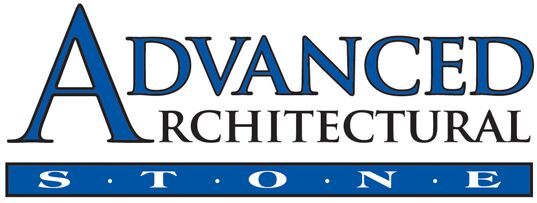Advanced Architectural Stone (AAS) provide different product materials options for projects –
- Cast Stone
- Architectural Precast
- Architectural GFRC (Glass Fiber Reinforced Concrete)
- GFRG (Glass Fiber Reinforced Concrete)
How do these products compare? How do you select a product material? Please refer to the tables below.
PRODUCT MATERIALS COMPARISON
| Basis | Cast Stone | Architectural Precast | Architectural GFRC |
|---|---|---|---|
| Definition | High quality masonry building material simulating limestone. | Masonry building material produced in larger sizes; can be visually comparable to cast stone with special finishing, but without special finishing more like concrete. | Masonry product made with glass fiber for strength with a hollow back having appearance of cast stone or precast at the option of the specifier. |
| Design | Made from graded aggregates, white Portland Cement, additives and color pigments | Consists of larger aggregates from 1″ to fine sands, additives and Portland cement. | Mix design same as precast with the addition of glass fiber for strength and face material visually the same as cast stone or precast. |
| Production Method |
Usually produced by dry cast method with very little moisture; compacting mix densely into molds. | Wet Method used; mix is poured into molds. Product sets up in mold overnight. | The product has a hollowunderside; strength through glass fibers. A wet pour method. |
| Structural / Non structural |
This product is self supporting but is not structural. | This product can be conventionally reinforced or pre-stressed to be structural. | Product is not structural but is self supporting through attachments. |
| Weight | 132 pounds per cubic foot | 150 pounds per cubic foot | Approximately 50% or less weight for same area covered than cast stone or precast. |
| Specification | Defined under Masonry Division – Section 4720 of the uniform building code. | Defined under Concrete Division – Specification 3450 of the uniform building codes. | Defined under Concrete Division – Specification 3490 of the uniform building codes. |
| Speed of Manufacture | Multiple pieces per day from mold; higher production output. | Usually 1 piece per day per mold; limiting daily production output. | Usually 1 piece per day; limiting daily production output. |
| Size | Usually less than 4′ in length; depends on depth or cubic value. | Can be larger pieces up to 20′ and can be structural. | Sizes can approximate both cast stone & precast. |
| Cost | Usually the most cost effective. | More expensive due to finishing to create close visual to cast stone and daily production limitation. | Most expensive to produce; higher cost offset by less installation costs. |
PRODUCT CHARACTERISTICS
| PRODUCT | REINFORCED | ANCHORAGE | FINISH | APPLICATION |
|---|---|---|---|---|
| Cast Stone (Dry) | Yes Rebar | Can have dowel holes; anchor slots, embedded hardware | Fine grain texture simulates Limestone | Architectural Trim, Facing, Ornamentation, columns |
| Architectural Precast | Yes Various methods | Cast in weld plates, Threaded inserts, Slots & Dowel holes | Exposed Aggregate, Form liners, Sandblasted , Visual bug holes unless finished to look close to cast stone. | Architectural panels, columns, Spandrels, Structural |
| GFRC | Yes Glass Fiber | Anchor bolts and steel frame attached to product at plant. | Fine grain texture or precast finish | Architectural, trim, facing, columns, spandrels; where lighter weight is helpful. |
| Limestone Grade II |
No | Cut in dowel holes and slots | Fine grain texture | Architectural trim, Facing, Ornamentation; long lead time |
| Calcium Silicate | No | Cut in dowel holes and slots | Smooth, Rocked, Press Hammered, Dressed | Architectural veneer, facing, and standard sizes only. |
PHYSICAL STANDARDS
| PRODUCT | ASTM | PSI (MINIMUM) | AIR CONTENT RANGE | ABSORBTION (MAXIMUM) | FREEZE-THAW (DURABILITY) |
|---|---|---|---|---|---|
| Cast Stone (Dry) | ASTM C 1364 | 6,500 | N/A | 6% | 5% Loss of mass or less @ 300 cycles |
| Cast Stone (Wet) | 6,500 | 4% – 6% | 6% | 5% Loss of mass or less @ 300 cycles | |
| Architectural Precast | CSI 3450 | 5,000 | 4% – 6% | 6% | Not required |
| GFRC | CSI 3490 | 1,200 (flexgard module of rupture) | 8% – 10% | Similar to Cast Stone / Precast | Similar to Cast Stone / Precast |
| Limestone Grade II | ASTM C 568 | 4,000 | N/A | 7.50% | Not available |
| Calcium Silicate | ASTM C 73-99A | Grade: NW 3,500 SW 5,500 | N/A | NW 18% SW 15% | Not available |
AAS team is able to combine different product materials as well to meet the design, structural and installation needs. AAS has experience with creating seamless design effects and uniform design appeal while combining different product materials on a same project.
Product Info/Reference Links
- AAS Product Materials
- Cast Stone
- Architectural Precast
- Architectural GFRC (Glass Fiber Reinforced Concrete)
- GFRG (Glass Fiber Reinforced Gypsum)






